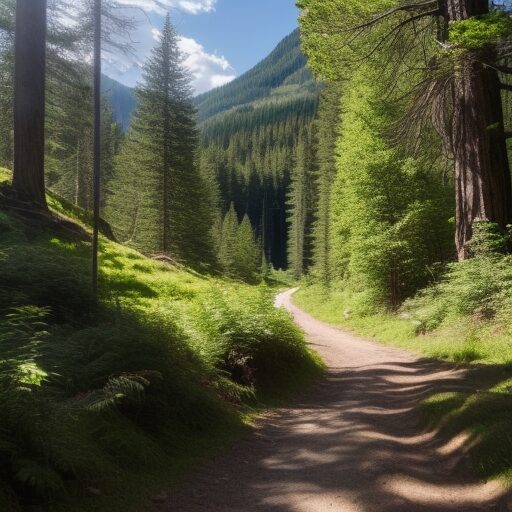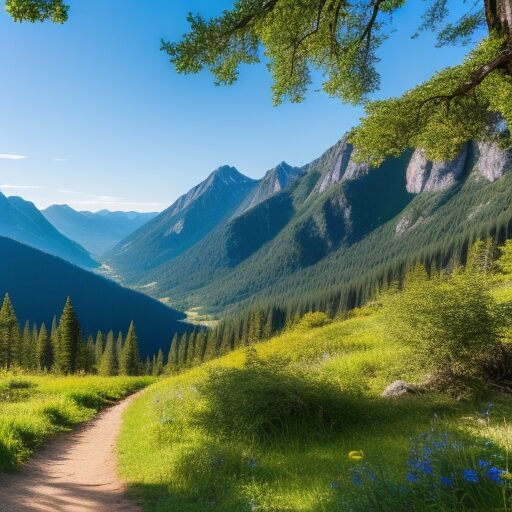Are you looking for a thrilling adventure to embark on? Look no further than these five breathtaking hiking trails that will leave you in awe. Each trail offers its unique challenges, scenic highlights, and historical significance. Pack your bags, lace up those boots, and get ready to trek through some of the most beautiful landscapes nature has to offer.
Introduction to the Trails
The first trail on our list is the famous Appalachian Trail. This 2,190-mile long trail stretches from Georgia to Maine and takes hikers through diverse terrain, including rocky mountains, dense forests, and serene meadows. The next trail is the Pacific Crest Trail, which spans over 2,650 miles from California to Washington state. It takes hikers through seven national parks and 25 wilderness areas, offering spectacular views of glaciers, volcanoes, and deserts along the way. The John Muir Trail, named after the famous naturalist, is a 211-mile trail located in California’s Sierra Nevada mountain range. It offers stunning vistas of Yosemite National Park, Kings Canyon National Park, and Sequoia National Park. The Continental Divide Trail is another iconic trail that runs along the Rocky Mountains from Mexico to Canada. It covers over 3,100 miles and takes hikers through remote wilderness areas, high alpine passes, and ancient Native American sites. Last but not least, we have the Camino de Santiago, a pilgrimage trail that winds through Spain for over 480 miles. It attracts thousands of hikers and pilgrims each year who seek spiritual enlightenment and cultural immersion.
The Best Time of Year for Hiking Each Trail
The best time to hike each trail varies depending on several factors such as weather conditions, wildlife activity, and crowd volume. For example, the Appalachian Trail is best hiked during spring or fall when temperatures are mild and crowds are smaller. The Pacific Crest Trail can be hiked from April to October, but late summer and early fall offer the best chance of catching glimpses of the Northern Lights. The John Muir Trail is typically open from June to September due to heavy snowfall during winter months. The Continental Divide Trail is best hiked from July to September when the weather is dry and warm. As for the Camino de Santiago, it can be walked anytime between March and November, with peak season being May to August.
Difficulty Levels and Skill Requirements
Each trail differs in difficulty level and skill requirements. The Appalachian Trail is considered moderate to difficult due to its length and rugged terrain. The Pacific Crest Trail is rated as one of the most challenging trails in the world due to its extreme elevation gain and loss, steep climbs, and harsh weather conditions. The John Muir Trail is also rated as a difficult trail due to its high altitude and technical sections. The Continental Divide Trail requires advanced backcountry skills and experience due to its remoteness and unpredictable weather patterns. Finally, the Camino de Santiago is considered an intermediate hike, although some parts may require more physical endurance.
Scenic Highlights Along the Way
These trails offer countless scenic highlights that will take your breath away. On the Appalachian Trail, hikers can enjoy panoramic views of the Blue Ridge Mountains, hike through the picturesque Great Smoky Mountains National Park, and marvel at the stunning beauty of Baxter State Park in Maine. The Pacific Crest Trail boasts incredible sights such as Mount Rainier, Crater Lake, and the Joshua Tree Forest. The John Muir Trail offers stunning vistas of Half Dome, El Capitan, and Yosemite Falls. The Continental Divide Trail provides opportunities to see wild horses roaming free, witness the annual elk migration, and explore ancient cliff dwellings. The Camino de Santiago takes hikers through charming medieval towns, lush green countrysides, and historic cathedrals.
Safety Tips and Precautions
Hiking these trails can be dangerous if proper precautions aren’t taken. Before setting out on your journey, make sure to research the area’s climate, terrain, and potential hazards. Bring appropriate gear such as good quality hiking shoes/boots, sun protection, insect repellent, and a reliable map and compass. Stay hydrated by carrying enough water and snacks. Let someone know where you’re going and when you plan to return. Be aware of wildlife and their behaviors, and avoid contact whenever possible. If you’re hiking in bear country, carry bear spray and follow recommended safety protocols. In case of emergency, know how to use your survival tools and signal for help.

Packing List and Essential Gear
Here are some essential items you should pack for your trip:
Good quality hiking shoes/boots
Lightweight and durable hiking clothes
Waterproof jacket and pants
Sun hat and gloves
Sunglasses
Map and compass
Flashlight or headlamp
First aid kit
Whistle
Multi-tool or knife
Fire starter
Food and snacks
Water filter or purification tablets
Bear spray (if applicable)
Emergency shelter
Personal locator beacon (PLB) or satellite messenger (SMG)
Local Wildlife and Plant Life You May Encounter
Each trail offers unique opportunities to observe local wildlife and plant life. On the Appalachian Trail, hikers might spot black bears, white-tailed deer, and wild turkeys. They may also come across rare plants such as lady slippers and orchids. The Pacific Crest Trail is home to a variety of animals such as mountain goats, bighorn sheep, and coyotes. Hikers may also encounter different species of trees such as Douglas firs, redwoods, and sequoias. The John Muir Trail allows visitors to view majestic peaks like Mt. Whitney and Mt. Williamson while observing rare flowers like the Sierra primrose and the alpine forget-me-not. The Continental Divide Trail offers chances to see herds of buffalo, pronghorn antelope, and even grizzly bears. The Camino de Santiago gives hikers the opportunity to spot various bird species such as eagles and falcons while walking through verdant fields and oak forests.

Historical Significance or Legends Associated with the Trails
These trails hold significant historical importance and legends associated with them. The Appalachian Trail was built by volunteers during the Great Depression as part of President Roosevelt’s New Deal program. The Pacific Crest Trail follows the route of the original transcontinental railroad and passes through several historic mining towns. The John Muir Trail honors the legacy of the famous naturalist who fought to preserve America’s wilderness areas. The Continental Divide Trail traces the path of Spanish explorer Juan de Oñate who led the first European expedition into the Southwest United States. The Camino de Santiago has been a pilgrimage destination since the




